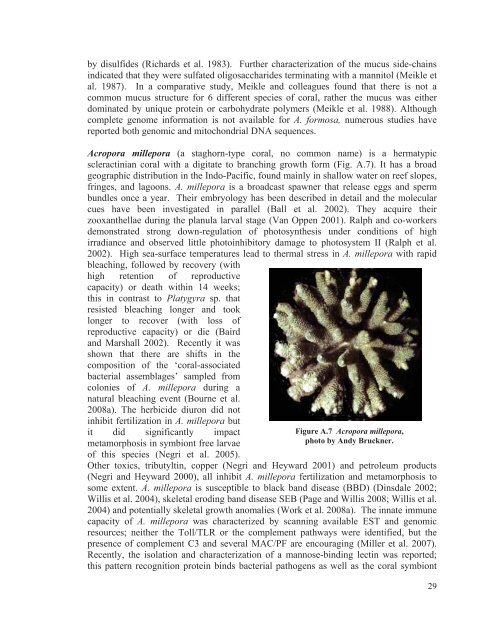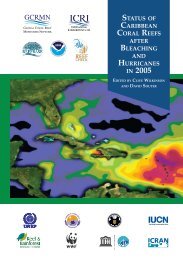Coral Health and Disease in the Pacific: Vision for Action
Coral Health and Disease in the Pacific: Vision for Action
Coral Health and Disease in the Pacific: Vision for Action
Create successful ePaper yourself
Turn your PDF publications into a flip-book with our unique Google optimized e-Paper software.
y disulfides (Richards et al. 1983). Fur<strong>the</strong>r characterization of <strong>the</strong> mucus side-cha<strong>in</strong>s<strong>in</strong>dicated that <strong>the</strong>y were sulfated oligosaccharides term<strong>in</strong>at<strong>in</strong>g with a mannitol (Meikle etal. 1987). In a comparative study, Meikle <strong>and</strong> colleagues found that <strong>the</strong>re is not acommon mucus structure <strong>for</strong> 6 different species of coral, ra<strong>the</strong>r <strong>the</strong> mucus was ei<strong>the</strong>rdom<strong>in</strong>ated by unique prote<strong>in</strong> or carbohydrate polymers (Meikle et al. 1988). Althoughcomplete genome <strong>in</strong><strong>for</strong>mation is not available <strong>for</strong> A. <strong>for</strong>mosa, numerous studies havereported both genomic <strong>and</strong> mitochondrial DNA sequences.Acropora millepora (a staghorn-type coral, no common name) is a hermatypicscleract<strong>in</strong>ian coral with a digitate to branch<strong>in</strong>g growth <strong>for</strong>m (Fig. A.7). It has a broadgeographic distribution <strong>in</strong> <strong>the</strong> Indo-<strong>Pacific</strong>, found ma<strong>in</strong>ly <strong>in</strong> shallow water on reef slopes,fr<strong>in</strong>ges, <strong>and</strong> lagoons. A. millepora is a broadcast spawner that release eggs <strong>and</strong> spermbundles once a year. Their embryology has been described <strong>in</strong> detail <strong>and</strong> <strong>the</strong> molecularcues have been <strong>in</strong>vestigated <strong>in</strong> parallel (Ball et al. 2002). They acquire <strong>the</strong>irzooxan<strong>the</strong>llae dur<strong>in</strong>g <strong>the</strong> planula larval stage (Van Oppen 2001). Ralph <strong>and</strong> co-workersdemonstrated strong down-regulation of photosyn<strong>the</strong>sis under conditions of highirradiance <strong>and</strong> observed little photo<strong>in</strong>hibitory damage to photosystem II (Ralph et al.2002). High sea-surface temperatures lead to <strong>the</strong>rmal stress <strong>in</strong> A. millepora with rapidbleach<strong>in</strong>g, followed by recovery (withhigh retention of reproductivecapacity) or death with<strong>in</strong> 14 weeks;this <strong>in</strong> contrast to Platygyra sp. thatresisted bleach<strong>in</strong>g longer <strong>and</strong> tooklonger to recover (with loss ofreproductive capacity) or die (Baird<strong>and</strong> Marshall 2002). Recently it wasshown that <strong>the</strong>re are shifts <strong>in</strong> <strong>the</strong>composition of <strong>the</strong> ‘coral-associatedbacterial assemblages’ sampled fromcolonies of A. millepora dur<strong>in</strong>g anatural bleach<strong>in</strong>g event (Bourne et al.2008a). The herbicide diuron did not<strong>in</strong>hibit fertilization <strong>in</strong> A. millepora butit did significantly impactmetamorphosis <strong>in</strong> symbiont free larvaeof this species (Negri et al. 2005).Figure A.7 Acropora millepora,photo by Andy Bruckner.O<strong>the</strong>r toxics, tributylt<strong>in</strong>, copper (Negri <strong>and</strong> Heyward 2001) <strong>and</strong> petroleum products(Negri <strong>and</strong> Heyward 2000), all <strong>in</strong>hibit A. millepora fertilization <strong>and</strong> metamorphosis tosome extent. A. millepora is susceptible to black b<strong>and</strong> disease (BBD) (D<strong>in</strong>sdale 2002;Willis et al. 2004), skeletal erod<strong>in</strong>g b<strong>and</strong> disease SEB (Page <strong>and</strong> Willis 2008; Willis et al.2004) <strong>and</strong> potentially skeletal growth anomalies (Work et al. 2008a). The <strong>in</strong>nate immunecapacity of A. millepora was characterized by scann<strong>in</strong>g available EST <strong>and</strong> genomicresources; nei<strong>the</strong>r <strong>the</strong> Toll/TLR or <strong>the</strong> complement pathways were identified, but <strong>the</strong>presence of complement C3 <strong>and</strong> several MAC/PF are encourag<strong>in</strong>g (Miller et al. 2007).Recently, <strong>the</strong> isolation <strong>and</strong> characterization of a mannose-b<strong>in</strong>d<strong>in</strong>g lect<strong>in</strong> was reported;this pattern recognition prote<strong>in</strong> b<strong>in</strong>ds bacterial pathogens as well as <strong>the</strong> coral symbiont29
















